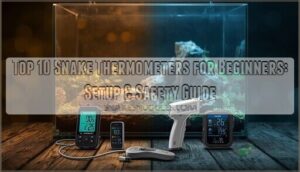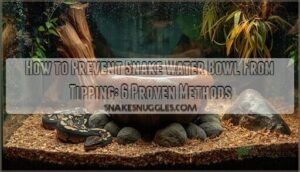This site is supported by our readers. We may earn a commission, at no cost to you, if you purchase through links.
When your snake starts wheezing or breathing with its mouth open, you’re witnessing something that would never happen in the wild—a compromised respiratory system struggling to function. Viral respiratory infections in snakes don’t respond to antibiotics, can’t be cured with a single medication, and won’t resolve without your intervention as a keeper.
Unlike bacterial pneumonia, which we can treat with antimicrobials, viral infections require a fundamentally different approach centered on supporting your snake’s immune system while it fights the pathogen. The key to successful treatment lies in creating an ideal healing environment through precise temperature control, targeted humidity management, and strategic supportive care protocols that address the cascade of physiological challenges these infections create.
Table Of Contents
- Key Takeaways
- What is Snake Viral Respiratory Infection?
- Recognizing Symptoms of Viral Respiratory Infection
- Diagnosing Viral Respiratory Infections in Snakes
- How to Treat Snake Viral Respiratory Infection
- Preventing Future Respiratory Infections in Snakes
- Frequently Asked Questions (FAQs)
- How to fix respiratory infection in snakes?
- What is the best treatment for viral respiratory infections?
- What is the medicine for respiratory infection in reptiles?
- How do I know if my snake has an upper respiratory infection?
- What antibiotics are used for snake respiratory infections?
- How do you get rid of a respiratory viral infection?
- What does a respiratory infection look like on a snake?
- How long does it take for symptoms to appear?
- Are certain snake species more susceptible to viral infections?
- Can viral respiratory infections in snakes spread to humans?
- Conclusion
Key Takeaways
- Viral respiratory infections in snakes can’t be treated with antibiotics and require supportive care focused on optimizing temperature (78-90°F basking zones), humidity (40-70% depending on species), and hydration to help the snake’s immune system fight the pathogen naturally.
- Early symptoms include open-mouth breathing, wheezing, nasal discharge with bubbles, lethargy, and appetite loss—requiring immediate veterinary diagnosis through PCR testing to distinguish viral from bacterial causes since treatment approaches differ fundamentally.
- Prevention depends on rigorous enclosure hygiene with EPA-registered disinfectants every 1-2 weeks, proper quarantine protocols for new snakes, and maintaining stable environmental conditions to minimize stress that weakens immune defenses.
- Pythons and boids show higher susceptibility to viral respiratory infections than colubrids, with overcrowded conditions, young age, and environmental stressors like improper temperature or humidity significantly increasing infection risk across all species.
What is Snake Viral Respiratory Infection?
When your snake develops a respiratory infection, understanding whether you’re dealing with a viral or bacterial cause shapes everything about treatment and recovery.
Viral respiratory infections in snakes stem from specific pathogens that behave differently than their bacterial counterparts, affect certain species more severely, and require a distinct approach to care.
Let’s explore the viral causes you need to recognize, how they differ from bacterial infections, and which snake species face the greatest risk.
Spotting symptoms early and knowing common snake health problems helps you decide when veterinary intervention becomes essential.
Common Viral Causes in Snakes
Unlike bacterial respiratory infections, viral respiratory conditions in your snake stem from specific viral pathogens that trigger distinct illness patterns. Paramyxovirus and serpentovirus have historically been implicated in respiratory symptoms, though newer discoveries reveal additional culprits affecting various snake species:
- Reptarenavirus (linked to inclusion body disease with respiratory tissue involvement)
- Fer de Lance calicivirus (associated with upper respiratory signs)
- Herpesviruses (causing nasal discharge and conjunctival symptoms)
- Nidoviruses (identified in respiratory disease presentations with viral shedding)
- Adenoviruses (contributing to snake respiratory infections, sometimes with secondary bacterial complications)
Understanding these viral pathogens improves infection control strategies. Researchers can utilize dictionary search tools to find relevant information on these viruses.
How Viral Infections Differ From Bacterial
Bacterial respiratory infections typically create localized symptoms—you’ll see focal lesions, isolated discharge—while viral respiratory conditions produce systemic signs affecting multiple organs simultaneously. Diagnostic tests reveal this distinction: bacterial infections respond to targeted antibiotics, whereas viral loads require supportive care since antivirals rarely work effectively. Your snake’s immune response differs markedly, too, making infection control strategies pathogen-specific. Understanding the importance of methodological rigor is essential in scientific studies related to viral infections.
| Characteristic | Viral Respiratory Conditions | Bacterial Infections |
|---|---|---|
| Replication | Requires host cells | Often independent |
| Symptoms | Systemic, multi-organ | Localized, focal |
| Treatment | Supportive care | Antibiotics |
| Diagnosis | Viral nucleic acids/antibodies | Cultures, Gram staining |
Species Most Susceptible to Viral Respiratory Disease
Certain snakes face higher respiratory disease risk than others. Pythonidae family members—especially those in overcrowded collections—show elevated viral respiratory infection rates, particularly as they age. Neonates and juveniles lack fully developed immune systems, making species susceptibility a significant factor.
Implementing comprehensive respiratory infection prevention strategies becomes especially critical for python keepers managing multiple animals in close quarters.
Arboreal and reef species experience heightened vulnerability when environmental stressors like improper temperature or humidity disrupt their reptile respiratory health, weakening their natural defenses against viral load factors.
Choosing safe bedding is crucial, as using poor substrates for snakes can worsen humidity problems and respiratory issues.
Recognizing Symptoms of Viral Respiratory Infection
Early detection is your best defense regarding viral respiratory infections in snakes. Knowing what to watch for can mean the difference between a manageable illness and a life-threatening crisis.
Respiratory issues often develop when environmental stress weakens immunity, so watch for early signs of snake stress-related illnesses like labored breathing or unusual lethargy.
Let’s walk through the key warning signs that should prompt immediate attention and a call to your reptile veterinarian.
Respiratory Signs (Wheezing, Open-Mouth Breathing)
When your snake starts breathing with its mouth open or you hear high-pitched wheezing during exhalation, you’re witnessing airway obstruction at work—clear respiratory symptoms signaling tracheal inflammation or breathing difficulty.
These respiratory sounds indicate a snake respiratory infection compromising respiratory health, often from mucus production blocking airways.
Watch for these warning signs of respiratory disease, especially during handling when increased airflow worsens the struggle.
Mucus Discharge and Nasal Bubbles
You’ll often notice clear to yellow nasal mucus pooling at your snake’s nostrils, sometimes forming visible bubbles during exhalation—classic respiratory signs of active infection.
This bubble formation and nasal discharge indicate nasal irritation compromising respiratory health in reptiles, with mucus consistency thickening as secondary bacterial involvement develops.
Proper mucus clearance becomes critical, since persistent respiratory symptoms signal your snake’s respiratory infection demands immediate veterinary attention for ideal snake health and wellness.
Behavioral Changes and Lethargy
Reduced activity often acts as your earliest warning that something’s wrong, with infected snakes spending prolonged periods motionless or showing markedly decreased responsiveness to handling—hallmark lethargy signs requiring behavioral monitoring.
You’ll notice disrupted sleep patterns, extended rest cycles, and diminished response to environmental triggers, all signaling respiratory symptoms affecting overall snake health and wellness.
Effective stress management becomes essential, since respiratory infections in reptiles directly compromise normal activity levels and alert behavior.
Loss of Appetite and Weight Loss
Appetite decline accompanied by progressive weight loss often signals respiratory disease severity, since infection-related stress and breathing difficulty directly suppress feeding drive in affected reptiles.
You’ll observe your snake refusing meals, exhibiting diminished interest in prey, and losing body condition—urgent signs requiring immediate veterinary intervention, aggressive hydration techniques, and customized nutrition therapy including appetite stimulation methods to support weight management and prevent dangerous depletion during respiratory infections.
Diagnosing Viral Respiratory Infections in Snakes
When your snake shows signs of respiratory illness, getting the right diagnosis isn’t just helpful—it’s essential for their survival. Viral respiratory infections require a different approach than bacterial or fungal causes, and only a qualified reptile veterinarian can tell the difference.
Let’s walk through what happens during a diagnostic workup and why each step matters for your snake’s recovery.
Importance of Veterinary Examination
You can’t treat what you can’t diagnose accurately—that’s where veterinary expertise becomes essential for snake health. A qualified veterinarian uses diagnostic tools like viral PCR panels and imaging to distinguish viral respiratory infections from bacterial or environmental causes, ensuring your treatment plans target the actual problem.
This medical guidance prevents unnecessary antibiotics, assists proper reptile health management, and dramatically improves outcomes through customized veterinary care.
Physical Examination Findings
During a veterinary physical exam, your snake’s respiratory signs reveal critical clues—wheezing, open-mouth breathing, and nasal discharge signal respiratory disease severity.
The vet assesses mucous membranes for color changes indicating hypoxia, evaluates body condition and hydration status through skin turgor and eye appearance, and documents behavioral changes like lethargy.
These findings guide which diagnostic tests are needed and determine the urgency of treating snake respiratory infection effectively.
Laboratory Tests and Viral Identification
Once your vet suspects viral respiratory disease, diagnostic protocols kick in—PCR analysis detects viral RNA or DNA with exceptional precision, serology tests reveal prior exposure through antibodies, and metagenomics research can even identify novel viruses causing infectious diseases in reptiles.
Key laboratory approaches for treating snake respiratory infection include:
- Viral load testing through polymerase chain reaction (highly sensitive for active infections)
- Cell culture isolation in specialized veterinary care for reptiles facilities (definitive confirmation)
- Next-generation sequencing from respiratory samples (identifies unknown pathogens without guesswork)
These tests distinguish viral from bacterial respiratory infections, ensuring targeted treatment.
Differentiating Viral From Other Respiratory Causes
Once you’ve identified respiratory pathogens through viral load testing, diagnostic challenges remain—bacterial infections often show focal lung consolidation on imaging, while viral respiratory diseases produce diffuse, bilateral patterns.
Species susceptibility factors also play a role; younger snakes face higher viral risks, whereas secondary bacterial involvement frequently follows initial viral insults.
Infection control measures depend on accurate differentiation, which combines PCR results, blood work patterns, and your snake’s clinical response to targeted therapies for peak respiratory health in reptiles.
How to Treat Snake Viral Respiratory Infection
Treating a viral respiratory infection in your snake isn’t about finding a magic cure—it’s about giving their body the best possible conditions to fight back. Unlike bacterial infections, viral cases require a different approach focused on supportive care, environmental optimization, and careful monitoring rather than antibiotics.
Treating viral respiratory infections in snakes requires supportive care and environmental optimization, not antibiotics or quick fixes
Here’s what you need to do to support your snake through recovery and prevent the infection from worsening.
Supportive Care and Hydration
Because viral respiratory infections can’t be cured with antibiotics, Supportive Care and Proper Hydration become your most powerful tools to help your snake’s immune system fight back. Fluid Management and Recovery Monitoring are essential components of maintaining Reptile Health during illness. Focus on these three priorities:
- Hydration Therapy: Provide multiple shallow water bowls and maintain species-appropriate humidity to support mucous membrane moisture without worsening respiratory symptoms.
- Nutritional Support: Offer small, easily digestible prey once appetite returns, preventing prolonged weight loss.
- Environmental Modifications: Keep temperatures within ideal ranges to support metabolic function while ensuring proper ventilation and strict Hygiene Practices to prevent secondary Respiratory Infections.
Medications and Nebulization Therapy
While hydration forms the foundation, nebulization therapy delivers targeted respiratory support by carrying bronchodilators or saline directly into your snake’s airways, promoting mucus clearance without systemic stress. Here’s what you need to know about medication safety:
| Therapy Type | Purpose | Veterinary Guidance Required |
|---|---|---|
| Nebulization | Delivers medication to respiratory tract | Yes—dosing protocols essential |
| Bronchodilators | Eases airway resistance | Yes—species-specific dosing |
| Antibiotics | Treats secondary bacterial infection only | Yes—not for viral infections |
Remember, antibiotic use isn’t appropriate for viral respiratory infections unless secondary bacterial complications develop—your vet will determine if antimicrobial therapy becomes necessary through careful monitoring.
Environmental Adjustments (Temperature, Humidity)
Once you’ve addressed hydration and nebulization therapy, Temperature Control and Humidity Management become your next frontiers—because respiratory health depends on thermal gradients that support immune function. Ventilation Systems promoting Air Quality prevent pathogen buildup while maintaining Habitat Conditions that reduce stress. Here’s your protocol for optimizing Snake Care:
- Maintain ambient temperature between 26–32°C with a 32–34°C basking spot for proper thermoregulation
- Target 40–60% humidity for colubrids, 50–70% for tropical species to minimize respiratory secretions
- Use calibrated digital devices, recording values twice daily to detect fluctuations
- Position shallow water bowls or humidifiers to sustain moisture without oversaturation
- Secure adequate airflow through screened lids or vents, preventing stagnant air that encourages Respiratory Infections
Remember, Hygiene Practices complement these environmental adjustments—clean substrates weekly and disinfect surfaces with reptile-safe solutions to support ongoing Respiratory Health during recovery.
Monitoring Recovery and Preventing Relapse
Vigilant Recovery Tracking through weekly weight checks and daily respiratory observations helps you catch Relapse Signs early—renewed wheezing, mucus, or lethargy signal trouble.
Post Treatment Care requires stable temperature gradients, continued Health Monitoring, and prompt Veterinary Care if symptoms resurface.
Effective Convalescence Support combines environmental control with routine assessment, safeguarding Respiratory Health and advancing Reptile Disease Prevention for your snake’s long-term wellness.
Preventing Future Respiratory Infections in Snakes
Prevention is always easier than treatment, especially regarding viral respiratory infections in snakes. By maintaining rigorous hygiene standards, optimizing your snake’s environment, and staying vigilant about potential stressors, you can greatly lessen the risk of future infections.
The following practices will help you create a healthier, safer habitat that fosters your snake’s long-term respiratory wellness.
Enclosure Hygiene and Disinfection Practices
Think of your snake’s enclosure as the frontline defense against respiratory infections—keeping it spotless isn’t optional. Effective enclosure hygiene and rigorous sanitation protocols can dramatically reduce pathogen buildup, which is central to disease prevention and management in reptile care and management.
- Use EPA-registered disinfectant types like quaternary ammonium compounds or hydrogen peroxide, ensuring proper contact time and thorough rinsing to protect your snake from residue irritation
- Establish cleaning schedules every 1–2 weeks, removing substrate before disinfection and using dedicated tools per enclosure to prevent cross contamination between animals
- Match your approach to enclosure materials—non-porous surfaces like glass tolerate standard agents well, while porous substrates may require complete replacement to eliminate embedded pathogens
Optimal Habitat Management
Beyond cleaning, you need to engineer an environment that actively promotes respiratory health through precise habitat design and environmental monitoring. Temperature control should maintain basking zones at 78–90°F with a proper gradient, while humidity management targets 40–60% for most species—levels that prevent mucous membrane drying without encouraging fungal growth.
Proper ventilation systems guarantee fresh air circulation, addressing respiratory infections at their source through vigilant reptile husbandry and ideal habitat conditions.
Reducing Stress and Quarantine Protocols
Stress management isn’t just comfort—it’s medicine. Maintain stable, species-appropriate ambient temperatures to minimize physiological stress, and implement gradual quarantine procedures before introducing new snakes to your collection.
During acute respiratory distress, limit handling techniques that increase anxiety.
Provide environmental enrichment through consistent reptile husbandry and management routines, using isolation methods that screen new arrivals before group housing to protect snake respiratory health.
Routine Health Monitoring and Vet Visits
Consistent veterinary care catches respiratory infections before they escalate. Schedule annual health checks with a reptile veterinarian experienced in snake respiratory health—more frequently for species prone to disease—and document weight, body condition, and husbandry parameters at each visit.
Your vet visit tips should include:
- Bringing photos of your enclosure setup for reptile care and maintenance review
- Tracking appetite, shedding patterns, and activity levels between appointments
- Discussing snake nutrition adjustments as your animal matures
- Requesting oral swabs if subclinical signs appear
- Reviewing reptile hygiene protocols and disinfection schedules
Frequently Asked Questions (FAQs)
How to fix respiratory infection in snakes?
Respiratory infections in snakes require veterinary guidance first. Your vet will determine whether bacterial or viral causes are present, then prescribe antibiotics if needed.
They will also adjust habitat maintenance for ideal respiratory care and monitor infection control throughout treatment.
What is the best treatment for viral respiratory infections?
The best treatment for viral respiratory infections combines supportive care—proper hydration, temperature regulation, and nebulization techniques—with close veterinary monitoring, since antiviral therapies aren’t routinely validated and antibiotics only address secondary bacterial complications.
What is the medicine for respiratory infection in reptiles?
Treatment usually involves supportive care, nebulization with saline, and appropriate antibiotics like enrofloxacin for secondary bacterial infections, though antivirals aren’t routinely used.
Always consult your reptile veterinarian for proper respiratory infection treatment.
How do I know if my snake has an upper respiratory infection?
You’ll notice your snake gasping with its mouth open, producing nasal discharge, or wheezing audibly when resting.
Watch for lethargy, reduced appetite, and weight loss—these infection indicators demand immediate veterinary attention for proper respiratory distress evaluation.
What antibiotics are used for snake respiratory infections?
Here’s the catch: antibiotics don’t work on viral respiratory infections in snakes, but when bacterial infections complicate matters, your veterinarian may prescribe enrofloxacin, amoxicillin-clavulanate, or ceftazidime based on bacterial culture results.
How do you get rid of a respiratory viral infection?
Getting rid of a respiratory viral infection requires supportive care. Prioritize hydration, improve environmental conditions, and monitor closely.
Antiviral treatment options remain limited. Most viral load reduction occurs through your snake’s immune response with proper veterinary medicine for reptiles guidance.
What does a respiratory infection look like on a snake?
Like a smoker struggling to catch their breath, infected snakes show nasal discharge with bubbles, open-mouth breathing, audible wheezing, lethargy, and reduced appetite—clear respiratory signs demanding immediate veterinary attention.
How long does it take for symptoms to appear?
Symptom onset usually appears 4 to 14 days after exposure, depending on the virus—paramyxovirus, serpentovirus, or others—viral load, and environmental factors like temperature and stress that influence incubation period and disease progression in respiratory infections.
Are certain snake species more susceptible to viral infections?
Yes, species susceptibility varies markedly—ball pythons and boids bear higher viral vulnerability compared to many colubrids.
Crowded captive conditions, genetics, and immune response differences drive these infection patterns, making proper snake care and management essential for respiratory infections and overall reptile health.
Can viral respiratory infections in snakes spread to humans?
No documented cases exist of snake respiratory viruses infecting humans. While zoonotic risk remains theoretical, standard hygiene—hand washing, protective equipment during clinical handling—minimizes any incidental exposure to viral respiratory diseases in captive collections.
Conclusion
Think of your snake’s immune system as a fire that needs oxygen to burn—without the right environmental conditions, even the strongest immune response will smolder and fail. Learning how to treat snake viral respiratory infection means becoming your animal’s life support system through precise temperature gradients, controlled humidity, and vigilant monitoring.
Your intervention transforms survival odds from uncertain to favorable, giving your snake’s natural defenses the foundation they need to overcome what antibiotics can’t touch.
- https://www.merckvetmanual.com/exotic-and-laboratory-animals/reptiles/parasitic-diseases-of-reptiles?query=reptile%20respiratory
- https://www.sciencedirect.com/book/9780323482530/maders-reptile-and-amphibian-medicine-and-surgery
- https://www.frontiersin.org/journals/veterinary-science/articles/10.3389/fvets.2019.00338/full
- https://vet.uga.edu/event/avian-reptile-small-mammal-endoscopy-online-on-demand-video-lecture-course/
- https://www.onelook.com/?loc=olthes1&w=subpoint













